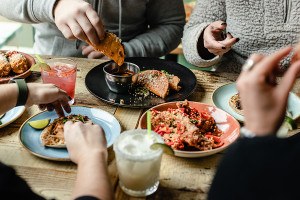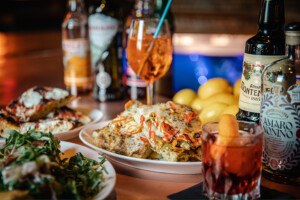No Reservations: The Trouble with Boston Dining Right Now
When every restaurant in town is the “it” spot and you can’t go out to eat on a whim, what happens to the magic of spontaneity?

Illustration by Zohar Lazar
Not so long ago, my friends and I found ourselves walking through the streets of Cambridge on what felt like a mundane, spur-of-the-moment mission: to go out for dinner. And we were fully prepared to stand around and wait for a table or accept seats at the bar to make it happen. When we slipped into a restaurant, I scanned the dining room. It was only 6 p.m., but the place was noisy and packed with diners chatting at every table. I approached the host stand, mentally gauging how long a wait my friends and I were actually willing to brave.
“Do you have any tables for three?” I asked.
“Do you have a reservation?” the host replied.
I told her that we did not. “Unfortunately, we are booked out for the remainder of the night,” she said. “I can put your name on a cancellation list in case any of our reservations don’t show up.”
I was confused. Was she telling me there wasn’t even a waitlist to join? I glanced over at the small bar, where every stool stood occupied.
“Could we put a name in to sit at the bar?” I asked. She looked apologetic. Alas, every bar seat was also reserved for the remainder of the night. The only option was to stand around, hoping someone would cancel or fail to show up.
There is little doubt that the experience of dining out has changed over the course of my life. I remember a time when I had to specify whether I wanted to sit in the smoking or nonsmoking section. Still, I’d never been to a restaurant in the Boston area where someone not only told me that there wasn’t a single table free for the entire night but also that there was neither a waitlist nor a barstool available.
The whole experience got me thinking about a recent shift in my own dining-out behavior. Once upon a time (by which I mean 2019), I’d make an online reservation for occasion dining—birthdays, celebrations—at an upscale restaurant. Now, I realized, I increasingly find myself doing it for any restaurant other than my local pub. So I started paying closer attention—how many reservations were available at restaurants where I wanted to dine, the number of times I couldn’t get a seat, and how often I was greeted with “Do you have a reservation?” instead of “Let me show you to a table,” even when walking into a less exclusive restaurant.
The more people I spoke with, from friends to restaurant industry pros, the more I realized that everyone was noticing the same thing: the spontaneous fun of walking into a restaurant had given way to the frustration of realizing the need to have made plans weeks—if not months—ahead of time. It all started to feel like a vicious cycle. After all, the more people make reservations, the more people must make reservations. Likewise, the more people who snag reservations three weeks out, the more people feel the need to book four weeks out. Not only does this recent phenomenon frustrate me to no end nearly every weekend, but it also makes me wonder if what was once a given—an open table at most restaurants—is closing its doors on diners for good.
Much like the end of working in an office and the demise of the handshake, you could say the death of walk-in dining was yet another pandemic casualty. While diners had already started using apps like OpenTable and Resy before COVID—after all, they’re quick and easy, and millennials are notorious for not wanting to actually pick up the phone—the use of reservation apps really took hold during the pandemic. None of the COVID-era restaurant restrictions—including the mandate to operate at a low capacity with no loitering at the bar if not eating—were conducive to walk-in culture and waitlists. To survive, says Steve Clark, president and CEO of the Massachusetts Restaurant Association, “a lot of places needed to know what they were going to actually have coming into the doors.”
At the same time, many reservation apps began offering an easy way to enforce cancellation fees for no-shows—something that had rarely been done pre-pandemic. This proved to be a vital asset when seating at restaurants became limited, says Jess Gooch, who recently became the general manager at Tonino in Jamaica Plain. “During the pandemic, whether or not a table sat empty for a two- or three-hour dining window could make or break your sales for the night.”
When the pandemic era ended, though, diners’ behavior stuck, and restaurants continued to rely on reservation apps due to a lingering shortage of seasoned restaurant staff. “All of a sudden, you had this less experienced, greener workforce,” says Jolyon Helterman, Boston’s former dining critic, relaying what many chefs had told him. A robust software system, it turned out, could fill in some of the gaps left by those experienced shift managers who were used to navigating the ebb and flow of diners with a pen and paper. These systems also offered restaurants more customer information than ever before—once a user signs up, for instance, the restaurant staff has an easy way to read, add, and store notes about a customer’s food allergies or whether they’re a frequent no-show, Helterman points out.
It’s not just restaurants that are driving more reservations—it’s also the customers. Four years post-COVID lockdown, a feverish thirst for a fun night out has continued to burn among diners. Sarma, the popular mezze restaurant in Somerville, has always been a tough table to get, but general manager Fernando Neves says that reservation madness is only on the rise. A year ago, at any given moment, Neves says Sarma’s digital waitlist for a reservation would have 800 names on it. These days, it’s up to a jaw-dropping 1,500 people every Saturday night of the year.
Diners, it seems, want certainty. “I hate waiting in lines,” my friend Andrew tells me, adding that he doesn’t like the anxiety of a night out with friends and not knowing if, or when, they’ll get a table for dinner. With a reservation, he says, “I know that people will be fed.”
In fact, relying on reservations has become so ingrained among Bostonians that it seems like no one wants to enter a restaurant without one. “If, for whatever reason, people have to walk through the door without a reservation, they’re tentative,” says Garrett Harker, the owner of Eastern Standard in the Fenway-Kenmore neighborhood. In fact, he says, instead of walking in and simply asking for a table, diners usually walk in and then immediately apologize for not having a reservation, even when it turns out there are plenty of open seats.
Despite the popularity of dining apps, some restaurateurs have reservations about the surge in reservations. “People say, ‘Oh my God, that’s a good problem to have,’” says Neves of Sarma’s 1,500-person reservation waitlist. “But at the same time, you want to say ‘yes’ to anyone” who wants to try the restaurant, which becomes impossible when so many people are already in the booking queue. Sarma currently allows diners to make reservations 30 days out; Neves considered expanding the period to three months but ultimately rejected it, he says, because not even a meal at Sarma could live up to the expectation created by waiting so long. “To book a month ahead, you’re already building that expectation with guests,” he says. “Three months? That’s crazy.”
Bostonians’ penchant for reservation-only dining also poses challenges for larger restaurants. Harker said he has more than 180 seats to fill each night at Eastern Standard, which is in a high-traffic neighborhood. The space—filled with booths, high tops, bar seating, and regular tables—can accommodate a range of diners who might be celebrating an anniversary, rushing off to a nearby concert, or grabbing a drink on a first date, giving the restaurant a great deal of flexibility and capacity for diners to drop by. Yet when it comes to reservations, “There’s no way I can book that out with 100 percent efficiency,” Harker says. “I have all different kinds of settings with different vibes, and I need walk-ins to fill those areas.” Sure, reservation systems might allow restaurants to book a given table at 6 p.m. and again at 8 p.m., but those systems can’t eyeball a group of diners and realize they’re going to be in and out in less than 45 minutes, opening a table again in time to usher in another set of diners. In fact, in an effort to convince diners they’re welcome any time, Harker is actually training his staff not to greet walk-ins by asking if they have a reservation.
Restaurant managers at Tonino and Sarma say that they want to serve their local communities, but it’s difficult when no one in the neighborhood can stroll in and score a table. To help, Sarma makes a point of leaving high tops and bar seats available for walk-ins, while Tonino leaves one table open for drop-ins, which may not seem like much, but it’s a decent chunk of real estate considering the business only holds 11 tables to begin with.
Meanwhile, Somerville’s Highland Kitchen may be a more casual restaurant, but it remains a rare holdout—a place that doesn’t take reservations at all. The lines forming outside its front door any Friday night is evidence that it could take reservations, but owner Mark Romano says he has no interest in it now and didn’t even during the challenges of COVID. He’s been in the restaurant business for decades, and the old way of doing things still tugs at his heart and mind. “Sometimes I say to the staff, ‘Let’s pretend like it’s 1980 and someone is just going to a restaurant because they heard it was good, and they walk into your restaurant and you blow them away with great service, good food, and then word of mouth starts,’” he says. “‘And it’s not because you posted a beautiful picture on the Internet.’”
Overall, it was clear in my conversations with food-industry pros that, in many ways, reservation systems have been a boon for restaurants. But it was easy to sympathize with Harker, who’d love it if diners could remember that it’s okay to head out without a reservation, and that it’s always worth checking with your favorite spots at the last minute instead of just settling for OpenTable or Resy, let alone DoorDash.
It’s hard not to miss the feeling of spontaneity that comes from deciding at the last moment to dine out.
For my part, I can’t help but feel slightly nostalgic for the feeling of spontaneity that comes from deciding at the last moment to dine out. One recent lazy Sunday morning, in fact, my partner and I were figuring out what to eat for breakfast. Was it a coffee-and-pastry kind of a day? Was it pancake time? No, we decided. On this summer Sunday, we wanted to splurge. We wanted someone to perfectly prepare eggs for us and keep refilling our coffee mugs, so we didn’t have to get up. We threw on our Sunday finest (band T-shirts) and strolled over to an upscale neighborhood spot, joking on the way about whether the host would immediately ask us if we had a reservation.
She did. We were promptly sent to the bar. As we chatted, I couldn’t help but notice that there were two empty tables nearby, which were soon joined by a third. By the time we left, only one of the empty tables had been claimed. The other two remained empty, patiently awaiting people with reservations.
We sat there for about an hour, served by a friendly and efficient bartender who kept our coffee cups full. The best part about it, though, was that we’d eaten the kind of brunch we’d only decided we wanted when we cooked up the idea in our pajamas a mere 20 minutes earlier. And no reservation could possibly compete with that.
First published in the print edition of the August 2024 issue with the headline, “Table for None?”


